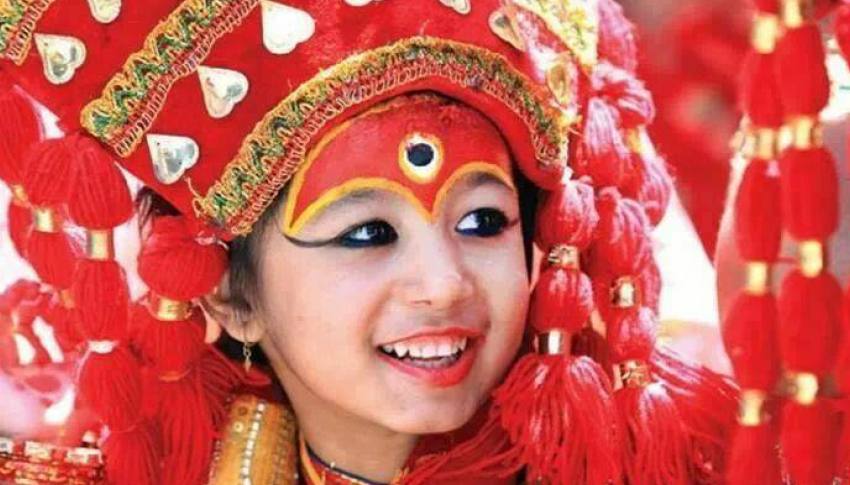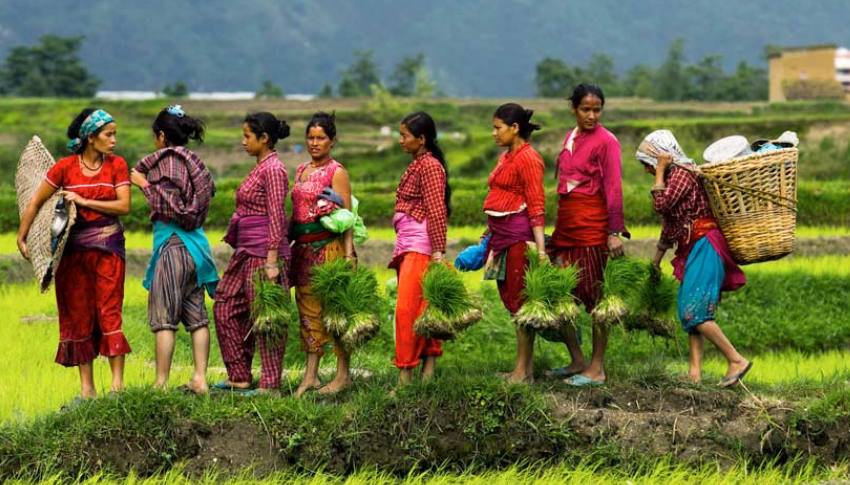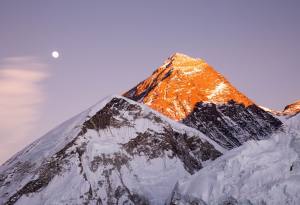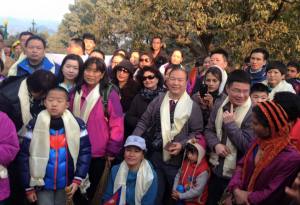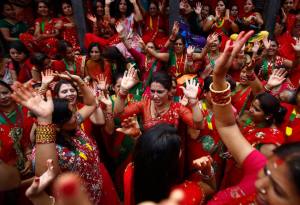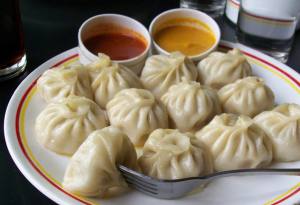Festivals in Nepal
Nepal is a country of festivals. In fact, the Nepalese are said to observe more festivals than the number of days in a year. Hardly a day passes without some festivities, ceremonial observances or pilgrimages occurring in some part of the country or the other. The following is a brief description of the major festivals observed in the country.
Navabarsha (Mid-April)
Navabarsha is the Nepalese New Year’s Day, which is a national holiday celebrated with great pomp and pageantry. Bhaktapur marks this occasion with a weeklong ceremony.
Biskat Jatra (April)
During this important festival, the old kingdom of Bhaktapur and its neighboring areas replay a drama passed coin over the centuries., Images of wrathful and some what demonic deities are placed on tottering chariots, They are offered blood sacrifices, flowers, and coins., Men brimming with youthful vigor and rice beer drag the chariots across brick-paved streets of the town, and wherever these raths stop, lamps are lit and devotees overflow into the surrounding alleys. Other gods and goddesses, too, are put on palanquins and carried around so that they may see the sights, At bode village, there is a tongue-boring ceremony in which the dedicated may reserve a place in heaven.
Red Machhendranath Jatra (May)
Until a few decades ago, before the Kathmandu valley became a purely commercial hub, it was an agricultural land which depended upon the rainy monsoon for its important rice crop. Today, though traditional farming practices have reduced, the pre-monsoon season still sees great worship made to Red Machhendranath- a rain god. Patan’s streets and palace complex are made even more evocative by wavering lamp and candle lights, women busily cooking feasts, and men gathering strength to pull the chariot of their red deity. As lord Macchendranath views his followers from the high seat of his chariot, its four wheels – representing the powerful Bhairab- receive rice and vermilion powder, the king of serpents is asked for blessings, and his jeweled vest is shown to the public.
Buddha Jayanti (May)
The ever-benevolent Buddha was born in Nepal. And the religion he preached is the second most popular in the kingdom, ON may 6, a full moon day, the Lord’s birth, enlightenment, and salvation are applauded throughout the valley with celebrations. Swayambhu and Boudhanath Stupas are prepared for the oncoming festivities several days in advance, Monasteries are cleaned, statues are polished, bright prayer flags waft in the breeze, and the monks prepare to dance,. On the Jayanti day, people reach the Stupas before dawn, go around them and give offerings to the many Buddha images there.
Rakshya Bandhan (August)
On Janai Purnima, a full moon day, high caste Hindus chant the powerful Gayatri Mantra and change their Sacred Thread (Janai), while a raksya bandhan, a red or yellow protection cord, is tied around the wrists of other Hindus. Pilgrims journey to the mountains north of Kathmandu; here they emulate Lord Shiva by bathing in the sacred lake of Gosaikund, Those unable to make the trek celebrate at Shiva’s Kumbheswar Mahadev temple. Here, a pool with an image of Shiva at center is filled with water believed to have come from Gosaikund.
Gai Jatra (August)
The gai, or cow, is holy to Hindus. She represents Laxmi, the goddess of wealth and guides the souls of the departed to the gates of the Netherworld, But Gai Jatra is not a somber occasion. Satire, jokes, fancy costumes, and colorful processions are the order of the day as people recall how an eighteen-century king rallied his people to cheer his queen upon the death of their son. Those who have experienced the death of close ones during the past year share their sorrow and take comfort in the fact that the gai has safely transported the departed souls on their afterlife journey.
Young men wearing women’s saris, children dressed up as cows, and whimsical characters of all sorts fill the streets. Special issues of local magazines poke fun at everyone and everything-even the most important people aren’t spared.
Indra Jatra (September)
Indra, king of heaven and controller of the rains, has once again blessed the valley. As the end of the monsoon nears, farmers look forward to a rich harvest: everyone is grateful to the deva for his help, For eight days, Kathmandu’s celebration fit to “ flatter the king of Heaven.” Indra’s dhwaj, or flag, is erected on the first day, It is said that many centuries ago, Indra’s mother needed specially-scented flowers but could not find them in heaven’s gardens, Indra discovered parijat flowers in the Kathmandu valley and tried to steal them for his mother, He was caught and imprisoned by the valley people, When Indra’s mother came searching for him the people were appalled by what they had done, They released Indra and dedicated one of the most colorful festivals of Nepal to him to appease his anger, Masks and statues representing Vishnu, Bhairab, and Shiva are shown to the public, and the Goddess Kumari witnessed this special occasion from her chariot. Indra is thanked for the rains and assured once again that he is respected in Kathmandu valley.
Dashain (October)
Dashain is the longest and most favorite festival of Nepal. Everyone stays home with his or her families, offices close and Radio Nepal plays Dasain music. The skies of Kathmandu are filled with kites . On the day of Dashami, everyone puts on new clothes and goes to honor their family elders, where they receive large tikas of vermilion paste on their foreheads. On the following days of Dasain, families and friends unite, feasts are consumed, blessing are imparted and gifts are exchanged, Nepal’s most beloved festival ends with the full moon.
Tihar (November)
Tihar, known as the festival of lights, is a time of candlelight, tinsel decorations and festive colored sweets, On different days, there are offerings and small celebrations for crows, dogs, cows and oxen. On the night of Lakshmi Puja, garlands are hung and lamps are lighted to invite Lakshmi, the goddess of wealth into the home, Mha Puja, the New Year’s Day according to the Nepal Era, is the day of the self, when people give themselves blessings to remain healthy and happy for the rest of the year. Bhai Tika the last day of Tihar, is the day when sisters make offerings to their brothers. The rituals of breaking a walnut, putting on garlands of makhamali flowers and encircling brothers in rings of mustard oil protects them from Yama, lord of the Netherworld.
Sweta Machhendranath Snan (January)
Sweta (white) Machhendranath enjoys a week-long festival in which he is bathed, oiled, perfumed and painted, The goddess Kumari visits him at his elaborate temle near Asan Tol. If he is pleased by the music, offerings, and attentions of his devotees, the people of the valley can look forward to satisfactory rainfall in the planting season.
Losar (February)
Losar is the Tibetan New Year. All the Tibetan- speaking populations most impressively observe this festival in the month of February. They organize folk songs and dances on this occasion. These dances can be seen in Khumbu, Helembu and other northern regions of Nepal and also at Boudhanath in Kathmandu.
Maha Shivaratri (February)
(New moon day of Falgun)
Maha Shivaratri, or the Great Night of Lord Shiva, is observed in honor of Lord Shiva’s day of birth. A great fair takes place at the Pashupatinath Temple as thousands of pilgrims from all parts of Nepal and India congregate in celebration.
Fafu Purnima / Holi (March)
(Full moon day of Falgun)
This is a colorful occasion when people smear each other with colored powder and splash water balloons onto one another. The Chir, pole is erected at the Kathmandu Durbar Square gaily decorated with colorful flags. That is the formal announcement to everybody to hide all his or her good clothes and to join in the revelry.

